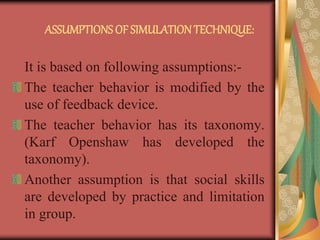SIMULATION PPT NEW.ppt
- 1. simulation
- 3. INTRODUCTION Simulation in simple terms attempts to initiate some real thing, processor a state of affairs. In todayĄŊs world simulation is an important way of teaching. Architects build models, doctors operate on frogs, rat or dead bodies, all have used simulation to teach concept.
- 4. DEFINITION Ą°Role playing in which the process of teaching is displayed artificially and an effort is made to practice some important skills of communication through this technique. The pupil- teacher and the students simulate the particular role of a person or actual life situation. The whole program becomes training in role perception and role playing.Ąą - Acc. to K.P.Neerja
- 5. ASSUMPTIONS OF SIMULATION TECHNIQUE: It is based on following assumptions:- The teacher behavior is modified by the use of feedback device. The teacher behavior has its taxonomy. (Karf Openshaw has developed the taxonomy). Another assumption is that social skills are developed by practice and limitation in group.
- 6. PRINCIPLES OF SIMULATION Players take on roles which are representatives of the real world and then make decisions in response to their assessment of the setting in which they find themselves. The experiences simulated are consequences which are related to their decisions and their general performance.
- 7. APPLICATIONOF SIMULATION IN TEACHER TRANING: Crruikshank has developed a teacher training system which includes: The participant is introduced into the situation (i.e. if she is a new teacher in a school). The participant is provided with information and opportunities to solve the problems. The participant is introduced to the situation by film strip.
- 8. The participant is also given the materials, e.g. the rules, regulations, handbook, curriculum and report card, to familiarize the topic. The participant is presented with role playing situation. The participant then identifies the factors influencing the problem. Locate the relevant information. Suggest alternative course of action. Small group discussion.
- 9. PROCEDURE OF SIMULATION This teaching is used for developing the social skill of teaching classroom situation. Generally the following steps are used: Selecting the role players Selecting and discussing skills Planning Deciding the procedure of evaluation Provided practical lesson
- 10. MERITS OF SIMULATION Student can learn without the harming the patients. It actively engages learners in the application of knowledge and skills in realistic situations. Students can receive feedback on the appropriateness of their action during simulation.
- 11. It permits application of theory to practice when access to clinical settings is limited or impossible. It is useful in promoting transfer of learning from the classroom to the clinical setting.
- 12. DEMERITES OF SIMULATION: It is costly in terms of both time and money. It cannot be divided in a fraction time. It can not be over used. Craftsmanship required for local construction. Usable for small group. Models often easily damaged.
- 13. ADVANTAGES OF SIMULATED TEACHING: Simulation establishes a setting where theory and practice can be combined. The student teachers are given opportunity to study and analyze critical teaching problem. The student can acquire classroom manners through the technique of simulation.
- 14. The student can understand behavioral problem of classroom and develop insight to encounter them The technique provides reinforcement to students to develop teaching skills and avoid the risk of actual classroom encounter. Simulation is a teaching device that motivates and involves students. It changes teacher behavior. Introduces novelty in the whole learning process.
- 15. Decision making skills into action. Role awareness- The individual when he plays the role of others becomes conscious of that role. Dynamic framework. It is holistic in nature. It permits the learner a greater flexibility in addressing facets of complexity.
- 16. Simulation works to bridge the gap between unreal and real situation and learning becomes more interesting and lively than purely theoretical.
- 17. LIMITATIONS OF SIMULATION Simulation cannot be made in all subjects of the curriculum. Simulation cannot be conveniently used in case of small children because mechanism is too difficult for them to follow. It requires a lot of preparation on the part of teachers. Minimum of feedback sequence to choose.
- 18. Time consuming. Difficulty in using analytic approach. Need for many simulators.
- 19. conclution Simulation in simple terms attempts to initiate some real thing, processor a state of affairs. It is a method of teaching through role playing by enacting artificially. In todayĄŊs world simulation is an important way of teaching.
- 20. write the assignment on simulation technique of teaching and perform simulation teaching in your class. submitted On 23/05/2015 at 12pm




















